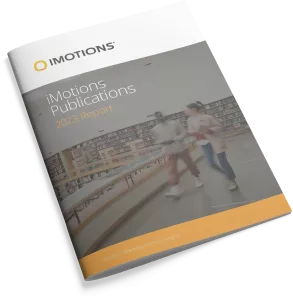-
Improving Driver Emotions with Affective Strategies
Abstract: Drivers in negative emotional states, such as anger or sadness, are prone to perform bad at driving, decreasing overall road safety for all road users. Recent advances in affective computing, however, allow for the detection of such states and give us tools to tackle the connected problems within automotive user interfaces. We see potential […]
-
Moderating effects of prior brand usage on visual attention to video advertising and recall: An eye-tracking investigation
Abstract: For advertisers, attracting attention to video marketing stimuli is paramount to building and refreshing consumers’ brand memories and increasing their propensity to purchase. Research has demonstrated brand users are more likely to recall advertising, possibly suggesting a brand’s commercials draw more attention from current users than potential new customers. Testing whether prior brand usage […]
-
Determining Consumer Preferences for Floral Design Elements
Floral designers have long been taught that the most important attributes of a floral design are the elements of line, color, texture, pattern, form, space, and size. Yet, little formal research has been conducted to determine which of these design elements are truly important to consumers and drive their purchasing behavior. This project, co-funded by […]
-
A Framework towards Quantifying Human Restorativeness in Virtual Built Environments
Abstract: The impact of built environment on the human restorativeness has long been argued; however, the interrelations between neuroscience and the built environment, and the degree to which the built environment contributes to increased human restorativeness has not been completely understood yet. Understanding the interrelations between neuroscience and the built environment is critical as 90% […]
-
The Effect of Taboo Content on Incidental Vocabulary Acquisition in a Foreign Language: A Facial Expression Analysis Study
Abstract: This study aims to examine how taboo content affects language learner psychology and language learning gains in a multi-modal learning environment by using facial expression analysis. 40 Muslim language learners were initially asked about their opinions on pork and watched a subtitled cooking video including pork visuals and their facial expressions were recorded. Before […]
-
Using both emotional responses and sensory attribute intensities to predict consumer liking and preference toward vegetable juice products
Abstract: Our previous research found that a combination of sensory attribute intensity and emotional responses helps in achieving better understanding of consumer acceptance and preference for basic taste solutions. By applying this finding to beverage samples, this study aimed to develop an optimum model of predicting either overall liking or preference of vegetable juice products […]
-
A Classification Model for Sensing Human Trust in Machines Using EEG and GSR
Abstract: Today, intelligent machines interact and collaborate with humans in a way that demands a greater level of trust between human and machine. A first step towards building intelligent machines that are capable of building and maintaining trust with humans is the design of a sensor that will enable machines to estimate human trust level […]
-
The Effect of Whole-Body Haptic Feedback on Driver’s Perception in Negotiating a Curve
Abstract: It remains uncertain regarding the safety of driving in autonomous vehicles that, after a long, passive control and inattention to the driving situation, how the drivers will be effectively informed to take-over the control in emergency. In particular, the active role of vehicle force feedback on the driver’s risk perception on curves has not been […]
-
Automatic Recognition of Posed Facial Expression of Emotion in Individuals with Autism Spectrum Disorder
Abstract: Facial expression is impaired in autism spectrum disorder (ASD), but rarely systematically studied. We focus on the ability of individuals with ASD to produce facial expressions of emotions in response to a verbal prompt. We used the Janssen Autism Knowledge Engine (JAKE®), including automated facial expression analysis software (FACET) to measure facial expressions in individuals […]
-
Copycat of dynamic facial expressions: Superior volitional motor control for expressions of disgust
Abstract: In social situations facial expressions are often strategically employed. Despite the many research on motor control of limb movements, little is known about the control over facial expressions. Using a response-priming task, we investigated motor control over three facial expressions, smiles, disgust and emotionally neutral jaw drops. Prime stimuli consisted of videos of a facial […]
Research Report 2023
In-depth look at the scientific landscape as powered by iMotions software, showcasing groundbreaking research and the impact of our tools in various scientific and industrial fields.

Share Your Research

850+ universities worldwide with an iMotions human behavior lab
73 of the top 100 highest ranked universities
710+ published research papers using iMotions
iMotions is used for some of the most interesting human behavior research studies carried out by top researchers around the world. Contact us to have your publication featured here.
The authors of these publications have used iMotions as a software tool within their research.
“Software should be cited on the same basis as any other research product such as a paper or a book; that is, authors should cite the appropriate set of software products just as they cite the appropriate set of papers” (Katz et al., 2020).
We therefore encourage you to cite the use of iMotions where appropriate.
How to cite iMotions
APA
iMotions (10), iMotions A/S, Copenhagen, Denmark, (2024).
Note: adjust the version and year where relevant.
5 Most Popular Blogs
Learn How to Conduct Human Behavior Research with iMotions
Publications
Read publications made possible with iMotions
Blog
Get inspired and learn more from our expert content writers
Newsletter
A monthly close up of latest product and research news





